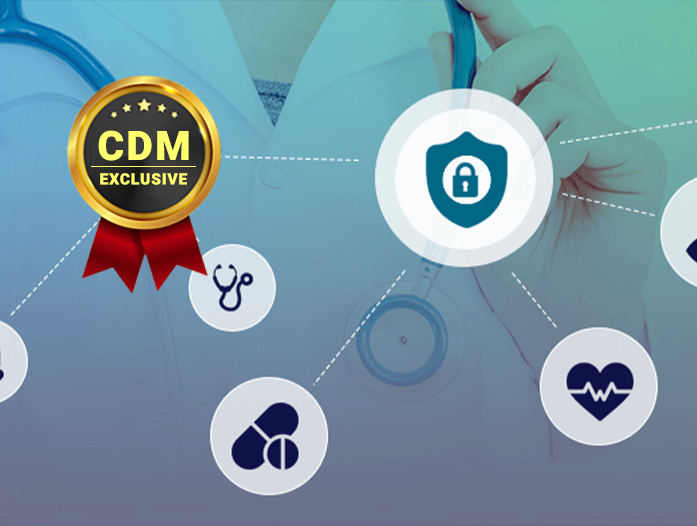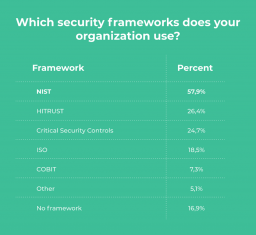- I tested a Pixel Tablet without any Google apps, and it's more private than even my iPad
- My search for the best MacBook docking station is over. This one can power it all
- This $500 Motorola proves you don't need to spend more on flagship phones
- Finally, budget wireless earbuds that I wouldn't mind putting my AirPods away for
- I replaced my Linux system with this $200 Windows mini PC - and it left me impressed
Cybersecurity in Healthcare: Benefits, Examples, and Usage Tips Healthcare cybersecurity framework

By Kate Orekhova, Cleveroad company
Health organizations deal with a large amount of sensitive personal information. That’s why they face challenges complying with tightening regulations, and they’re constantly combating increased cyber risks and adapting to digital transformation.
The healthcare institutions have to prove that technologies and methods they adopted keep patients’ personal information secure and bring no risks. And using recognized standards and frameworks is a great decision.
In this guide, we discuss how to apply security frameworks in healthcare, along with recognizing well-known cybersecurity frameworks.
What Does Cybersecurity Framework Mean?
Cybersecurity framework (CSF) is a mix of processes, technologies, and practices designed to reduce cybersecurity risks in different fields, including healthcare. Moreover, the framework helps organizations operate sensitive data and predict security risks due to its adaptive and practical approach.
In short, the frameworks are the guidelines to secure IT systems.
But a framework isn’t a panacea from all misfortunes. It offers a common language and methods for combating cybersecurity-related threats but isn’t the only way to secure sensitive data.
CFS is updated depending on each organization. That’s why CFS is based on questions healthcare institutions should ask themselves to manage their risks effectively and in the right direction. And while technologies and standards may transform – the principals stay.
The primary goals of cybersecurity frameworks:
- Defining the current security situation
- Outlining target security position
- Constant improvement
- Analyze progress towards the target position
- Communication risk
But what is the structure of these frameworks?
There are three fundamental pillars of a CSF:
- The core
- Implementation layers
- Profiles
Let’s consider each of them in detail.
- Framework core is based on cybersecurity activities and rules designed to reach a particular result. Its function is to inform about cybersecurity risks across an organization
- Implementation layers help associations by determining how they understand cybersecurity management. They help to reveal the right level of thoroughness for a security program and warn about cyber risks across an organization
- Profiles are a set of organizational objectives and premises, and assets against the framework’s primary outcome. They reconcile industry standards and common practices, support priority settings and measurement according to the business goals
Why Use CSF in Healthcare?
Hospitals and other healthcare are vulnerable to security threats.
That’s why they need safeguards that private data will be secured within an organization and meet industry and federal requirements.
Besides, healthcare is one of the industries where internal cybersecurity threats are more dangerous than external ones. According to the Verison report, 59% of all cybersecurity threats are internal compared to 42% of external incidents.
Most often, it happens because of human errors. Hospital employees may misuse their power and access to the internal systems and information they store. In this case, it’s better to build your own CRM compliance with ISO 27001 standards to reduce frequent cyber-attacks and data breaches. For example, it happens when the hospital staff wants to know what procedures celebrities take. No surprise that 6% of breach incidents happen because of “just for fun.”
So how exactly do CFS resolve these matters?
Let’s take the example of the most popular health cybersecurity framework – NIST.
First, CSF is used to detect, react, protect and recover from the influences of security threats and their consequences. It’s not a rule book for healthcare institutions, but an experience of best practices of IT security. And hospitals use these guidelines to strengthen their existing cybersecurity policies.
Second, the NIST healthcare cybersecurity framework provides security implementing its core elements, implementation layers, and a profile that coordinates them with business requirements, financial capabilities, and resilience to risk.
CSF helps both external and internal stakeholders understand and handle cybersecurity together as a team. It’s a tool that lets healthcare entities coordinate business policy with a tech one.
It improves security risk management across the whole organization. And, thus, it leads to better outcomes. It’s crucial when it comes to providing healthcare services to patients or enhanced operational efficiency with personnel.
Health CSF Adoption
Finally, it’s time to provide medical cybersecurity and work on CSF implementation. Let’s consider what steps most organization take when it comes to framework adoption:
- Step 1: Determine core tasks and organizational components
- Step 2: Define current risk management approaches
- Step 3: Make a risk management profile
- Step 4: Assess the risks
- Step 5: Create a risk management profile based on the evaluation results
- Step 6: Create an action plan
- Step 7: Implement the plan
Now, let’s take a closer look at framework adoption steps.
- Prioritize and make the scope
Before starting cybersecurity action, hospitals need to determine the primary goals and priorities. Thus, they can make strategic decisions regarding the security standards and find the systems and tools that hold the selected process.
And CSF implementation starts with creating a strategy for framing, estimating, analyzing, and responding to risks. This way, a healthcare institution understands how and where to utilize the framework and analyze threats and impacts.
- Orient
First, the organizations check what resources they have (tools, technologies, data, personnel). They also choose the appropriate regulatory agency and look for authoritative sources (security standards, methods, risk management rules, and so on).
Second, they carefully weigh the overall risk approach and determine the system’s weak points.
- Work on a Target Profile
The organization determines its own risk factors and does an overlay of the healthcare framework. After, the entity sets the overlay to block any threats and breaches. Moreover, organizations may also build their own Categories and Subcategories to report for unique risks. They identify the category and subcategory of the results they are dealing with from the framework core.
- Estimate the risks
At this stage, healthcare organizations figure out the level of risk to the information system. They analyze possible security risks and the consequences they may cause.
- Create a Current Profile
The healthcare institutions make a detailed risk evaluation and determine their current posture. It’s better to conduct an assessment from both the functional area and independently across the organization.
Risk assessment aims at understanding current cybersecurity risks in the healthcare industry. Thus, all the breaches and vulnerabilities should be found and documented.
- Define, analyze and prioritize the gaps
After finding all the risks and impacts they cause, healthcare entities should provide a gap analysis to compare the actual results with the target ones. For instance, they may design a heat map showing the results clearly. With this approach, it’ll be easy to find the areas that need to be improved. Then, organizations brainstorm to understand what they should do to fill the gaps between current and target outcomes.
- Realization step
Finally, by understanding possible cybersecurity challenges in healthcare and having a list of necessary actions, medical organizations can adopt the framework.
Indeed, it doesn’t end just with implementing the action plan. Companies should structure and analyze metrics to ensure their efficiency and that their CSF is meeting the company’s expectations. The major purpose of this process is to get the maximum benefit and customize the framework to meet business needs.
Best Framework Examples in Healthcare
In 2018, HIMSS conducted a “Cybersecurity Survey” to know what medical cybersecurity frameworks are in demand in the healthcare sector. Let’s take a look at five popular cybersecurity frameworks and the reasons why healthcare entities implement them.

- NIST Healthcare Framework
NIST CFS is the commonly used security framework in many industries, including healthcare. It’s a USA-based company that develops lots of tech standards and rules, data security included.
The best-known NIST documents are:
NIST Framework for Improving Critical Infrastructure Cybersecurity
NIST SP 800-53 for Security and Privacy Controls for Federal Information Systems and Organizations
NIST SP 800-171: Protecting Controlled Unclassified Information in Nonfederal Systems and Organizations
NIST CSF is based on threat modeling, intelligence, and collaboration. By using it, healthcare organizations not just execute a required analysis of future risks, but remove emerging threats and collaborate with other institutions.
- HITRUST
HITRUST framework ranks second in cybersecurity frameworks: 26,4% of frameworks users use the Health Information Trust Alliance guidelines.
HITRUST is a private organization working with the best specialists in the healthcare industry. Their major goal is to make data security the foundation of information systems. That’s why their CSF strives to satisfy organizations’ needs by offering specific guidance.
The programs involve standard risk establishment, an estimation and assurance methodology, awareness, and so on. Moreover, the framework uses the ISO/IEC 27001:2005 Information Security Management system and supports business associates worldwide.
- Critical Security Controls
Critical Security Controls, created by the Center for Internet Security, is a set of practices aimed to prevent healthcare cyber attacks. In CSC, all the controls are started from the most important ones like operating vulnerabilities or providing an inventory of assets.
Generally, CIS Controls is used with other CFS, for example, NIST.
- ISO 27000 Series
ISO stands for International Organization for Standardization. It’s a non-governmental company that creates standards to uphold world trade. ISO follows measures to create and maintain an information security management system – ISO/IEC 27000.
This framework can be used in the healthcare sphere to manage complex and changing requirements of data security.
- COBIT CFS
COBIT CFS is an IT governance tool. It lets healthcare institutions fill the gap between control requirements and helps with policy development.
COBIT is aimed at the effectiveness of the IT sphere more than at the security of business processes. However, many companies utilize the CSF to adopt practices developed by other security standards, for example, the NIST healthcare cybersecurity framework and ISO 27001/2.
Hospitals and insurance companies join other organizations (financial institutions, private corporations, governments) in implementing COBIT.
Wrapping Up
Cybersecurity framework implementation can be a difficult task due to its constantly changing rules and requirements. However, it’s vital to apply these frameworks in the healthcare sphere to prevent cybersecurity-related threats on time.
About the Author
 Kate Orekhova is a content writer at Cleveroad. It’s a mobile and web development company in Ukraine. Alina enjoys writing about cybersecurity technology and AI innovations.
Kate Orekhova is a content writer at Cleveroad. It’s a mobile and web development company in Ukraine. Alina enjoys writing about cybersecurity technology and AI innovations.

